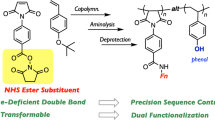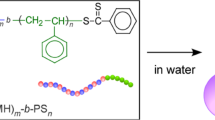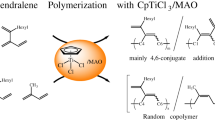Abstract
A sulfur-containing styrene derivative, 4-methylenethiochromane (META), was subjected to anionic copolymerization with isoprene (Ip) modified with different additives. The reactivity of META can be effectively regulated with additives; thus, gradient and alternating copolymers were prepared in a facile manner. When THF and TMEDA were utilized in the copolymerization, the reactivity was better than that observed without additives, and thus, gradient copolymers with different gradient extents can be synthesized. In addition, metal alkoxides (such as sodium 2,3-dimethylpentan-3-olate (NaODP) and potassium tert-butoxide (t-BuOK)) were better able to regulate the reactivity, and the copolymers exhibited alternating and nearly alternating sequences. Therefore, the regulation of the alternating or gradient copolymerization of META and Ip was facilely realized through the use of additives.
This is a preview of subscription content, access via your institution
Access options
Subscribe to this journal
Receive 12 print issues and online access
$259.00 per year
only $21.58 per issue
Buy this article
- Purchase on Springer Link
- Instant access to full article PDF
Prices may be subject to local taxes which are calculated during checkout





Similar content being viewed by others
References
Pakula T, Matyjaszewski K. Copolymers with controlled distribution of comonomers along the chain, 1. Structure, thermodynamics and dynamic properties of gradient copolymers. Computer simulation. Macromol Theory Simul. 1996;5:987–1006.
Paris R, De la Fuente JL. Glass transition temperature of allyl methacrylate-n-butyl acrylate gradient copolymers in dependence on chemical composition and molecular weight. J Polym Sci Part B: Polym Phys 2007;45:1845–55.
Mok MM, Kim J, Torkelson JM. Gradient copolymers with broad glass transition temperature regions: Design of purely interphase compositions for damping applications. J Polym Sci Part B: Polym Phys 2008;46:48–58.
Davis KA, Matyjaszewski K. Statistical, gradient, block, and graft copolymers by controlled/living radical polymerizations. Polym Int 2003;52:1553–4.
Petruczok CD, Barlow RF, Shipp DA. Synthesis of poly(tert-butyl acrylate-block-vinyl acetate) copolymers by combining ATRP and RAFT polymerizations. J Polym Sci Part A: Polym Chem 2008;46:7200–6.
Matsuo Y, Konno R, Ishizone T, Goseki R, Hirao A. Precise synthesis of block polymers composed of three or more blocks by specially designed linking methodologies in conjunction with living anionic polymerization system. Polymers 2013;5:1012–40.
Seki A, Ishizone T, Oyane A, Yokoyama H. A segregation and deprotection approach for hydrophilic surfaces using amphiphilic block copolymers possessing polystyrene and poly (tri(ethylene glycol) methacrylate) segments. Macromol Chem Phys 2017;218:1700048.
Grune E, Bareuther J, Blankenburg J, Appold M, Shaw L, Müller AHE, et al. Towards bio-based tapered block copolymers: the behaviour of myrcene in the statistical anionic copolymerisation. Polym Chem 2019;10:1213–20.
Nakahara A, Satoh K, Kamigaito M. Random copolymer of styrene and diene derivatives via anionic living polymerization followed by intramolecular Friedel–Crafts cyclization for high-performance thermoplastics. Polym Chem 2012;3:190–7.
Wu LL, Ma HW, Wang QY, Li L, Wang YR, Yang L. In-chain multi-functionalized random butadiene–styrene copolymer via anionic copolymerization with 1,1-bis(4-dimethylaminophenyl)ethylene: synthesis and its application as a rubber matrix of carbon black-based composite. J Mater Sci 2014;49:5171–81.
Wilms D, Schömer M, Wurm F, Hermanns MI, Kirkpatrick CJ, Frey H. Hyperbranched PEG by random copolymerization of ethylene oxide and glycidol. Macromol Rapid Comm 2010;31:1811–5.
Matyjaszewski K, Ziegler MJ, Arehart SV, Greszta D, Pakula T. Gradient copolymers by atom transfer radical copolymerization. J Phys Org Chem 2000;13:775–86.
Qin SH, Saget J, Pyun JR, Jia SJ, Kowalewski T, Matyjaszewski K. Synthesis of block, statistical, and gradient copolymers from octadecyl (meth)acrylates using atom transfer radical polymerization. Macromolecules 2003;36:8969–77.
Lee HI, Matyjaszewski K, Yu S, Sheiko SS. Molecular brushes with spontaneous gradient by atom transfer radical polymerization. Macromolecules 2005;38:8264–71.
Lucon J, Qazi S, Uchida M, Bedwell GJ, LaFrance B, Prevelige PE Jr, et al. Use of the interior cavity of the P22 capsid for site-specific initiation of atom-transfer radical polymerization with high-density cargo loading. Nat Chem 2012;4:781–8.
Boyer C, Stenzel MH, Davis TP. Building nanostructures using RAFT polymerization. J Polym Sci Part A: Polym Chem 2011;49:551–95.
Moad G, Chong YK, Postma A, Rizzardo E, Thang SH. Advances in RAFT polymerization: the synthesis of polymers with defined end-groups. Polymer 2005;46:8458–68.
Biswas CS, Mitra K, Singh S, Ray B. Synthesis of low polydisperse isotactic poly(N-isopropylacrylamide)s in environment-friendly and less toxic methanol-water mixtures by RAFT polymerization. J Chem Sci 2016;128:415–20.
Ray B, Isobe Y, Morioka K, Habaue S, Okamoto Y, Kamigaito M, et al. Synthesis of isotactic poly(N-isopropylacrylamide) by RAFT polymerization in the presence of Lewis acid. Macromolecules 2003;36:543–5.
Galanos E, Grune E, Wahlen C, Müller AHE, Appold M, Gallei M, et al. Tapered multiblock copolymers based on isoprene and 4-methylstyrene: influence of the tapered interface on the self-assembly and thermomechanical properties. Macromolecules 2019;52:1577–88.
Huang W, Ma HW, Han L, Liu PB, Yang LC, Shen HY, et al. Synchronous regulation of periodicity and monomer sequence during living anionic copolymerization of styrene and dimethyl- 4-(1-phenylvinyl)phenyl silane (DPE-SiH). Macromolecules 2018;51:3746–57.
Eisenbach CD, Lenz RW. Solvent and counterion effects in the anionic polymerization of α,α-disubstituted β-propiolactones. Makromol Chem 1976;177:2539–45.
O’Driscoll K, Patsiga R. Solvent effects in anionic copolymerization. J Polym Sci Part A: Gen Pap. 1965;3:1037–44.
Liu PB, Ma HW, Huang W, Han L, Hao XY, Shen HY, et al. Sequence regulation in the living anionic copolymerization of styrene and 1-(4-dimethylaminophenyl)-1-phenylethylene by modification with different additives. Polym Chem 2017;8:1778–89.
Natori I, Inoue S. Living anionic polymerization of 1,3-cyclohexadiene with then-butyllithium/N,N,N‘,N‘-tetramethylethylenediamine system. copolymerization and block copolymerization with styrene, butadiene, and isoprene. Macromolecules 1998;31:982–7.
Joosten GEH, Ingenluyff RAC, Douwes HSA. Aspects of reactor design for the anionic copolymerization of styrene and butadiene to a random copolymer. Ind Eng Chem Proc Des Dev 1979;18:441–6.
Kraus G, Gruver JT. Melt Viscosity of Random Copolymers of Butadiene and Styrene Prepared by Anionic Polymerization. Transactions of the Society of Rheology. 1969;13:315–22.
Qiang W, Liao MY, Wang YR, Zhang CQ. Effects of 1,2-butadiene on the anionic copolymerization of styrene and 1,3-butadiene in the presence of polar additives. Polym Int 2007;56:1021–8.
Hutchings LR, Brooks PP, Parker D, Mosely JA, Sevinc S. Monomer sequence control via living anionic copolymerization: synthesis of alternating, statistical, and telechelic copolymers and sequence analysis by MALDI ToF mass spectrometry. Macromolecules 2015;48:610–28.
Yang LC, Ma HW, Han L, Liu PB, Shen HY, Li C, et al. Sequence features of sequence-controlled polymerssynthesized by 1,1-diphenylethylene derivatives with similar reactivityduring living anionic polymerization. Macromolecules 2018;51:5891–903.
Ito S, Goseki R, Senda S, Hirao A. Precise synthesis of miktoarm star polymers by using a new dual-functionalized 1,1-diphenylethylene derivative in conjunction with living anionic polymerization system. Macromolecules 2012;45:4997–5011.
Hirao A, Negishi Y, Hayashi M, Sako K, Sang WR, Loykulnant S, et al. Living anionic polymerization of monomers with functional groups, 15. anionic polymerization and reaction of styrene and 1,1-diphenylethylene derivatives substituted with alkoxymethyl groups. Macromol Chem Phys 2015;202:3590–605.
Yang LC, Ma HW, Han L, Hao XY, Liu PB, Shen HY, et al. Synthesis of a sequence-controlled in-chain alkynyl/tertiary amino dual-functionalized terpolymer via living anionic polymerization. Polym Chem 2018;9:108–20.
Liu PB, Ma HW, Huang W, Shen HY, Wu LL, Li Y, et al. The determination of sequence distribution in the living anionic copolymerization of styrene and strong electron-donating DPE derivative-1,1-bis(4-N,N-dimethylanimophenyl)ethylene. Polymer 2016;97:167–73.
Sang W, Ma HW, Wang QY, Hao XY, Zheng YB, Wang YR, et al. Monomer sequence determination in the living anionic copolymerization of styrene and asymmetric bi-functionalized 1,1-diphenylethylene derivatives. Polym Chem 2016;7:219–34.
Zhang YM, Han L, Ma HW, Yang LC, Liu PB, Shen HY, et al. The investigation on synthesis of periodic polymers with 1,1-diphenylethylene (DPE) derivatives via living anionic polymerization. Polymer 2019;169:95–105.
Li J, He JP. Synthesis of sequence-regulated polymers: alternating polyacetylene through regioselective anionic polymerization of butadiene derivatives. ACS Macro Lett 2015;4:372–6.
Steube M, Johann T, Galanos E, Appold M, Rüttiger C, Mezger M, et al. Isoprene/styrene tapered multiblock copolymers with up to ten blocks: synthesis, phase behavior, order, and mechanical properties. Macromolecules 2018;51:10246–58.
Ma HW, Wang QY, Sang W, Han L, Liu PB, Sheng HY, et al. Facile synthesis of dendrimac polymers via the combination of living anionic polymerization and highly efficient coupling reactions. Macromol Rapid Comm 2016;37:168–73.
Liu PB, Ma HW, Shen H, Han L, Chang S, Zang L, et al. Study on the mechanism of a side coupling reaction during the living anionic copolymerization of styrene and 1-(Ethoxydimethylsilyphenyl)-1-phenylethylene (DPE-SiOEt). Polymers 2017;9:171.
Bai HY, Zhang Z, Ma HW, Han L, Mu XC, Huang W, et al. Investigation of the features in living anionic polymerization with styrene derivatives containing annular substituents. Polym Chem 2019;10:1140–9.
Liu PB, Ma HW, Han L, Shen HY, Yang LC, Li C, et al. Investigation of the locked-unlocked mechanism in living anionic polymerization realized with 1-(tri-isopropoxymethylsilylphenyl)-1-phenylethylene. Angew Chem Int Ed 2018;57:16538–43.
Acknowledgements
This work was financially supported by the National Natural Science Foundation of China (Nos. 21674017, 21871037, and 21805025).
Author information
Authors and Affiliations
Corresponding author
Ethics declarations
Conflict of interest
The authors declare that they have no conflict of interest.
Additional information
Publisher’s note Springer Nature remains neutral with regard to jurisdictional claims in published maps and institutional affiliations.
Supplementary information
Rights and permissions
About this article
Cite this article
Bai, H., Han, L., Ma, H. et al. Investigation on the alternating and gradient anionic copolymerization of 4-methylenethiochromane (META) and isoprene modified with additives. Polym J 52, 145–152 (2020). https://doi.org/10.1038/s41428-019-0273-5
Received:
Revised:
Accepted:
Published:
Issue Date:
DOI: https://doi.org/10.1038/s41428-019-0273-5



